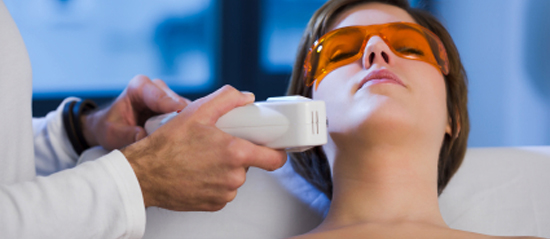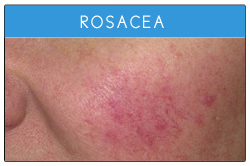Symptoms

Rosacea & Redness

Rosacea (roz-ay-sha) is a very common red, acne-like benign skin condition that affects many people worldwide. As of 2010, rosacea is estimated to affect approximately 45 million worldwide. Most people with rosacea are Caucasian and have fair skin. The main symptoms of rosacea include red or pink patches, visible tiny broken blood vessels, small red bumps, sometimes containing pus, red cysts, and pink or irritated eyes. Most people with the disease may not even know they have rosacea or that it is a diagnosable and treatable condition. Many people who have rosacea may just assume they blush or flush easily or are just very sun sensitive.
Rosacea is considered a chronic (long-term), skin condition with periodic ups and downs. As opposed to traditional or teenage acne, most adult patients do not "outgrow" rosacea. Rosacea characteristically involves the central region of the face, causing persistent redness or transient flushing over the areas of the face and nose that normally blush -- mainly the forehead, the chin, and the lower half of the nose. It is most commonly seen in people with light skin and particularly in those of English, Irish, and Scottish backgrounds. Some famous people with rosacea include the former U.S. President Bill Clinton and W.C. Fields. Rosacea is not directly related to alcohol intake.
Rosacea is not considered contagious or infectious. There is no evidence that rosacea can be spread by contact with the skin, sharing towels, or through inhalation.
The redness in rosacea, often aggravated by flushing, may cause small blood vessels in the face to enlarge (dilate) and become more visible through the skin, appearing like tiny red lines (called telangiectasias). Continual or repeated episodes of flushing and blushing may promote inflammation, causing small red bumps that often resemble teenage acne. In fact, rosacea can frequently be mistaken for common acne. Rosacea is also referred to as acne rosacea.
Rosacea is currently not considered a curable condition. While it cannot be cured, it can usually be controlled with proper, regular treatments.
There are some forms of rosacea that may be significantly cleared for long periods of time using laser GMAX PRO and/or IPL, intense pulse light.
Many patients are now turning to laser and intense light treatments to treat the continual redness and noticeable blood vessels on the face, neck, and chest. Often considered a safe alternative, laser and intense pulse-light therapy may help to visibly improve the skin and complexion.
Laser treatment may cause some discomfort. While most patients are able to endure the procedure, ice packs and topical anesthetic cream can help alleviate the discomfort. Multiple treatments are recommended in three- to six-week intervals; during this time, sun avoidance is necessary.
To control and improve rosacea you will find the AQUA RESCUE and AQUAFOLIA clinical care and home product line. This treatment is an anti-redness, anti-inflammatory, soothing and hydrating care that favors the skin's natural ability to defend itself against the abuse of the elements.
The A/K capsules from Vivierskin are an incredible vasoconstrictor for the capillaries. Specifically formulated for reactive skin prone to localized redness these soothing medical grade gel capsules provide a unique combination of Vitamins A (Retinol), K, C and E and soothing Green Tea to help combat redness and blotchiness, reduce the appearance of fine lines and rebuild the skin’s natural protective barrier.




